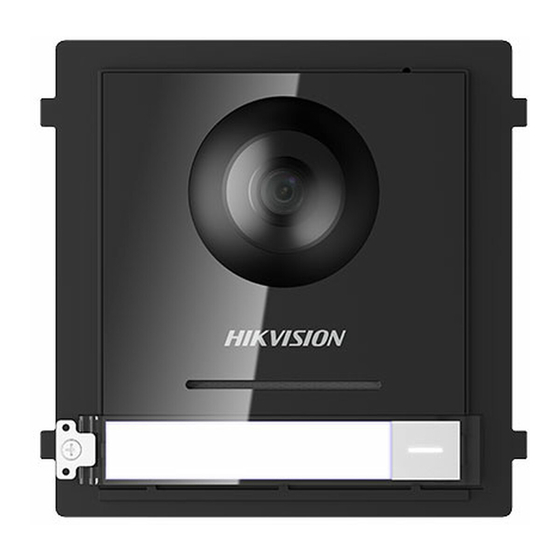
Table of Contents
Advertisement
Advertisement
Table of Contents

Summarization of Contents
Legal Information
About this Manual
Provides information on the manual's content, purpose, and obtaining the latest version.
Regulatory Information
FCC Information
Details FCC compliance statements and conditions for operating the device.
EU Conformity Statement
Mentions compliance with EU directives like EMC and RoHS.
Industry Canada ICES-003 Compliance
States compliance with Industry Canada standards for digital devices and radio apparatus.
3 Terminal and Wiring
3.1 Terminal Description
Describes the terminals and interfaces on the main unit.
3.2 Module Door Station Wiring
Details the wiring procedures for the module door station.
3.2.1 Door Lock Wiring
Explains how to wire the door lock mechanism, including magnetic locks and electric strikes.
3.2.2 Door Contact Wiring
Details how to connect the door contact sensor for status detection.
3.2.3 Exit Button Wiring
Describes the wiring for the exit button to unlock the door.
3.2.4 RS-485 Card Reader Wiring
Provides instructions for connecting an RS-485 card reader.
4 Installation
4.1 Configure Sub Module Address
Explains how to set the unique address for sub-modules using DIP switches.
4.2 Two-Module Installation
Guides on installing two modules, including surface and flush mounting.
4.3 Three-Module Installation
Details installing three modules, covering surface and flush mounting methods.
4.4 Multi-Module Installation
Covers installation for combinations of more than three modules.
5 Activation
5.1 Activate Device via Client Software
Guides on activating the door station using the client software and setting a password.
5.2 Edit Network Parameters
Details how to configure network parameters for LAN operation using client software.
6 Remote Configuration via Web
6.1 Live View
Explains how to access and view the live feed from the device via a web browser.
6.2 User Management
Describes how to add, delete, and search user information for the device.
6.3 Device Management
Outlines managing linked devices, including adding, importing, exporting, and deleting.
6.4 Remote Configuration Options
Covers various remote configuration settings like parameters, system, network, and events.
6.4.3 Network Settings
Guides on configuring network parameters like IP address, subnet mask, and gateway.
6.4.4 Video & Audio Settings
Details configuring video stream type, resolution, bitrate, and audio parameters.
6.4.5 Image Settings
Covers image adjustment, display settings, WDR, brightness, and day/night modes.
6.4.6 Event Settings
Configures motion detection, sensitivity, and event linkage actions.
6.4.8 Intercom Settings
Manages device numbers and linked devices for intercom communication.
6.4.9 Access Control Settings
Configures door parameters, elevator control, and permission passwords.
6.4.10 Theme Settings
Allows setting advertisements and screen savers on the device's main page.
7 Configuration via Client Software
7.1 Device Management
Covers device activation, adding, editing, and deleting within the client software.
7.1.1 Add Online Device
Explains how to add active online devices to the client software.
7.1.2 Add Device by IP Address
Details adding devices using their IP addresses.
7.2 Live View via Door Station
Guides on viewing live video from the door station using the client software.
7.3 Remote Configuration
Provides options for remote configuration via client software.
7.3.1 Device Management
Manages linked devices, including adding, importing, exporting, and deleting.
7.3.2 Local Parameters Settings
Configures live view, record files, and captured pictures via client software.
7.3.4 Network Settings
Guides on configuring network parameters like IP address, subnet mask, and gateway.
7.3.5 Video & Audio Settings
Details configuring video stream type, resolution, bitrate, and audio parameters.
7.3.6 Image Settings
Covers image adjustment, display settings, WDR, brightness, and day/night modes.
7.3.7 Schedule Settings
Allows creating call schedules for indoor stations.
7.3.8 Intercom Settings
Manages device numbers and linked devices for intercom communication.
7.3.9 Access Control Settings
Configures door parameters, elevator control, and permission passwords.
7.4 Organization Management
Manages organizational structure, including adding and modifying organizations.
7.5 Person Management
Manages person information, including adding, modifying, and issuing cards.
7.5.3 Import and Export Person Information
Imports and exports person information in batch using Excel files.
7.5.4 Get Person Information from Device
Retrieves person information from a device and imports it to the client.
7.5.6 Issue Card in Batch
Issues multiple cards to persons without cards in batch.
8 Video Intercom Operation
8.1 Video Intercom Operation via Device
Details how to call residents, issue cards, and unlock doors using the device.
8.1.1 Call Resident
Explains how to call residents using different modules like main, nametag, keypad, and display.
8.1.2 Issue Card
Explains how to issue cards locally or remotely.
8.1.3 Unlock Door
Describes unlocking the door using passwords or cards.
8.2 Video Intercom Operation via Client Software
Manages video intercom functions, call logs, and notices via client software.
8.2.1 Receive Call from Door Station
Guides on receiving and handling calls from the door station within the client software.
8.2.2 Live View via Door Station
Accesses live video feeds from the door station using the client software.
8.2.3 View Call Logs
Checks call logs, including dialed, received, and missed calls.
8.2.4 Search Video Intercom Information
Searches call logs, unlocking logs, and notice information within the client software.
A. Relevant Instructions for External Power Supply and Wiring of 2-wire Video Intercom Products (2020-1-20)
Power Description
Details power consumption of distributors, door stations, and indoor stations.
Device Installation
Covers installation environment requirements and connection guidelines for modules and stations.
B. Communication Matrix and Device Command
Communication Matrix
Provides a QR code to access the device communication matrix.
Device Command
Offers a QR code for accessing common serial port commands.
















Need help?
Do you have a question about the DS-KD-INFO and is the answer not in the manual?
Questions and answers